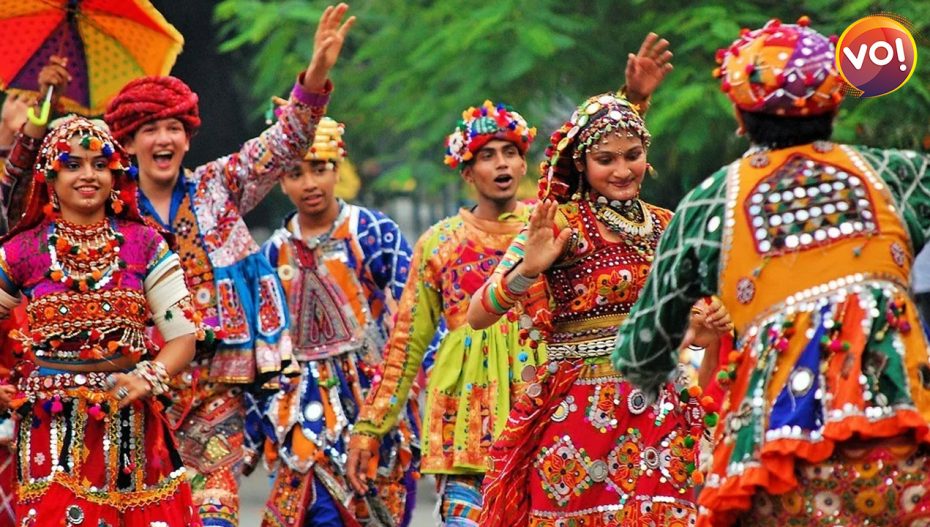With its recent addition as one of the chapters in UNESCO’s Intangible Cultural Heritage list, ‘Gujarat ka Garba’ (Garba of Gujarat) is unfurling its traditional charm and aesthetic spirit across the world.
To preserve its art and cultural legacy, India has nominated the typical Gujarati folk-dance-form ‘Garba’ for its inclusion in UNESCO’s intangible cultural heritage list. The latest nomination will be considered for next year’s listing.
The folk-dance-form Garba has its origin from India’s western Gujarat state. The word ‘Garba’ has been derived from the Sanskrit term ‘Garbha’ that means ‘womb’. The speciality of this dance lies in its appearance and practice. It is performed around the clay lantern with a light inside called ‘Garbha Deep’ or ‘Womb lamp’ – representing light as a foetus (in the form of life) within the womb.
The dancers honour Goddess Durga, a principal form of shakti (power). Legend has it, Durga was created by the super trinity- Brahma (the creator), Vishnu (the protector) and Mahesh (the destroyer) to slay the notorious demon ‘Mahishasura’.
The folk dance is performed in a circle to signify the symbol of ‘Kalchakra’ (wheel of time), also known as ‘time circles’. The performers revolve in circles, as time in Hinduism is cyclical and thus as the cycle of time moves, the ‘form of life from birth to death’ also moves along, and takes a rebirth again.
Another adage that goes around Garba is – The only thing, which is constant throughout is the Goddess ‘Durga’. The whole transformation of human life takes place in her caress. The ‘matka’ (earthen vessel) signifies the body within which the Goddess Durga resides. This representation is known as the ‘Garbha Deep’ (Lamp within the womb). The dancers in the form of human life perform around this symbolic representation of Durga and please the goddess to get her blessings.
In the recent past, ‘Dandiya Raas’ (a traditional dance-form performed mainly by men) has heavily influenced Garba. In their attractive attire, both the men and women perform Garba and Dandiya together.
The traditional ‘Chaniya choli’ (a three-piece dress with a blouse, flared skirt and dupatta with bandhni-‘tie-die’) is a highly colourful (red, pink, yellow, orange, and all bright colours), vibrant, flowy and heavily embroidered outfit.
The women performers also wear heavy jewellery- necklaces, sparkling bangles, waist belts, and long oxidised earrings. Traditionally, men wear an ethnic kediyu (a long-sleeved upper garment) and a ‘pajama’ or a ‘dhoti’ (a traditional lower garment worn by men) with an oxidised bracelet and necklace. Normally, the dandiya sticks are wooden.
The dance is performed during the nine-day Navratri celebration held annually during the month of Ashwin (September or October). On a few occasions, men also participate, but women are the main performers of Garba. It is considered as the longest dance festival in the world.
During this extraordinary celebration of Navratri festival, Gujarat Tourism has witnessed an increase in footfall on an year-on-year basis. Every year, the state government plans ahead with a host of events lined up in an effort to get a heavy tourist attraction.
This dance form celebrates ‘fertility’, ‘honour the womanhood’, and pays respect to all the nine forms of mother goddesses.
‘Garba’ has become very popular across the world in recent times. In the United States of America, nearly 20 universities carry out competitions with professional choreography on ‘Garba’. Canada’s Toronto too hosts the largest annual garba performance in the entire region of North America. The dance-form has also solidified a large number of audience in the United Kingdom, where a significant number of Gujarati communities organise garba nights every year.
Earlier in December 2021, the Intergovernmental Committee of UNESCO’s 2003 Convention on Safeguarding the Intangible Cultural Heritage included Durga Puja to its 2022’s representative list. Durga Puja was inscribed on the coveted list at the committee’s 16th session held at Paris, France. The committee had commended Durga Puja for its initiatives to involve marginalised groups, specially participation of women in safeguarding its element and values.
India, currently has 14 Intangible Cultural Heritage (ICH) elements that are inscribed on the list- Ramlila, Vedic Chants, Kumbh Mela, Kalbelia, Chhau Dance, Buddhist Chanting, Koodiyattam, Mudiyett, Nawruz, Sankirtana, Ramman, Traditional Brass and Copper Craft of Utensil making, Yoga, and the latest being Kolkata’s Durga Puja.












